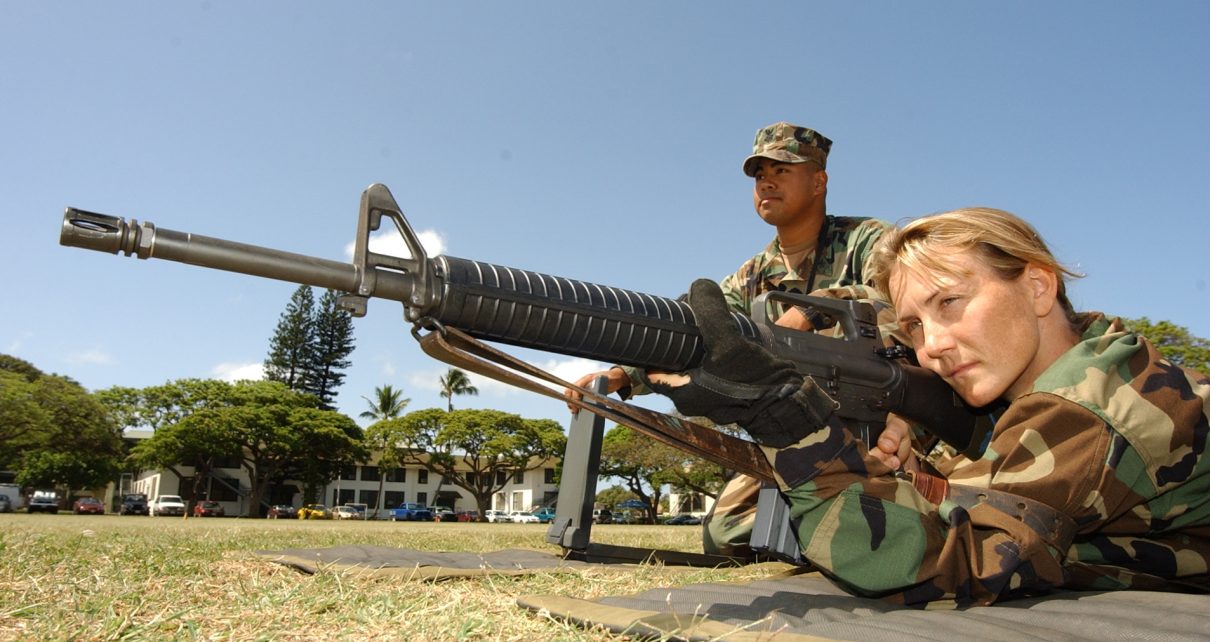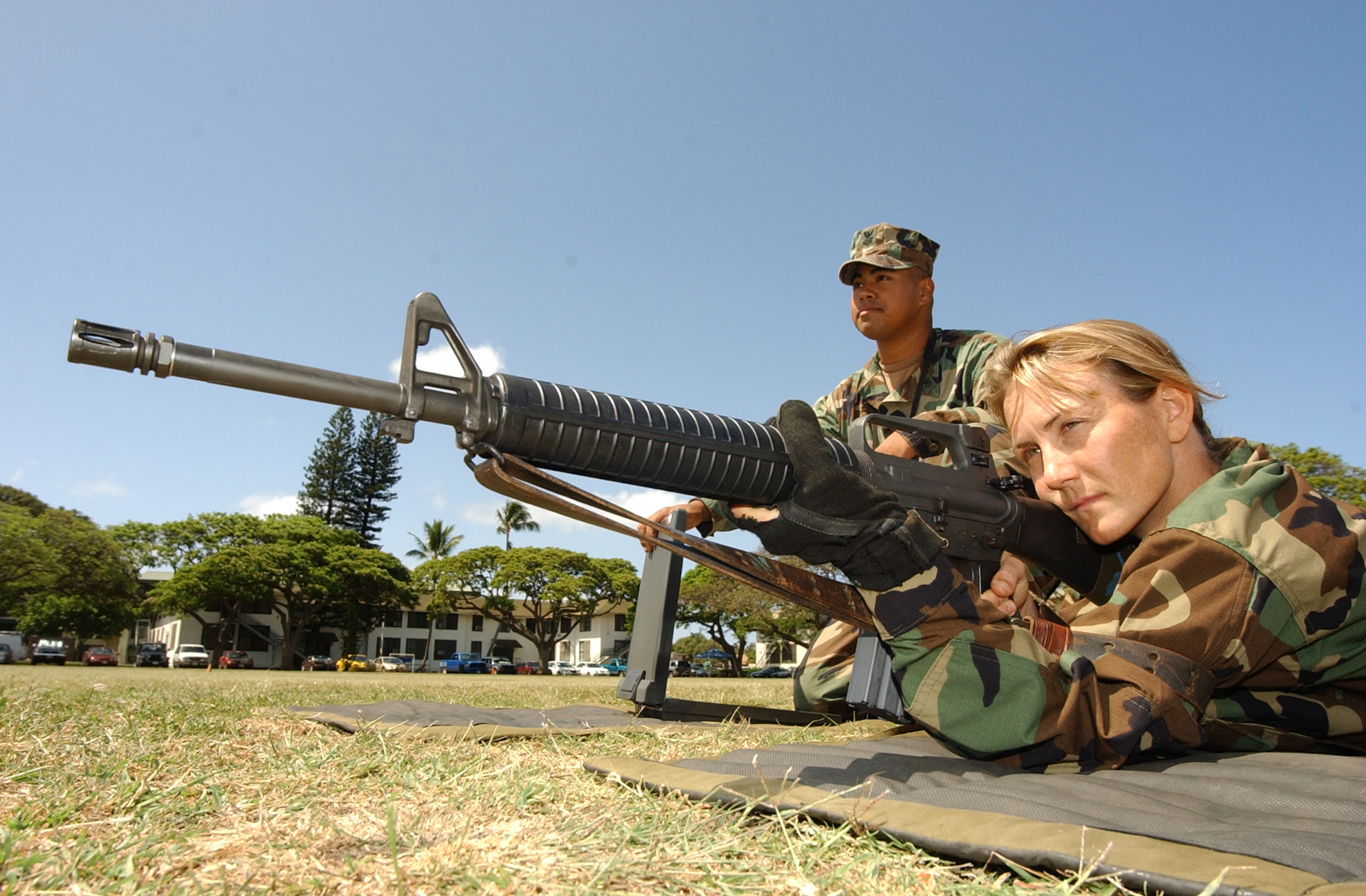The U.S. Armed Forces prepares recruits for handling a pistol or rifle through different means.
While the U.S. Army and Marine Corps focuses on marksmanship utilizing rifles or automatic weapons, the Navy has a different process.
Consequently, the Navy rifle and pistol qualification is a different type of test that is part of your responsibilities at basic training.
Recruits that train for the Navy rifle and pistol qualification also compete for the Marksmanship Medal.
The award is the highest weapons qualification granted in both the U.S. Navy and Coast Guard.
Learn more about Navy rifle and pistol qualifications to prepare for boot camp.
Related Article – US Army Rifle Training and Qualification Standards
Table of Contents
Navy Rifle and Pistol Qualification – Orientation
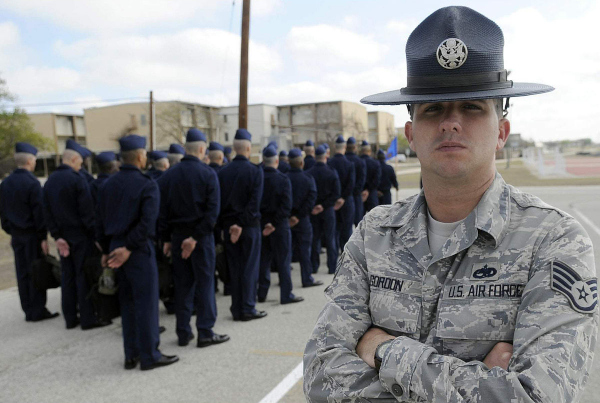
The United States Navy divides its marksmanship qualifications into two separate categories: 1) shotgun and 2) pistol.
As a result, the Navy ditches the typical M-16 rifle utilized during other types of training for the Mossberg 500 shotgun and M-9 pistol.
However, even before you start to handle a weapon directly, the Navy provides simulated training on a computer system.
Thus, recruits spend several hours of weapons training in a classroom and simulated environment prior to hands-on training.
The Navy rifle and pistol qualification is one of the better military training programs, as the classroom segment introduces recruits to safety practices.
Navy recruits learn how to draw and holster the weapon properly along with proper cleaning procedures.
For this reason, recruits are much better prepared and aware of safety procedures prior to the first time they step on a firing range.
They already possess the knowledge to safely load, handle, and unload the two weapons used during basic training.
Consequently, if you have limited experience handling or firing weapons prior to enlistment you shouldn’t fret too much.
The U.S. Navy gradually introduces its recruits to weapons in basic training so they can develop confidence and awareness.
Classroom studies also focus on the fundamentals of marksmanship, including the characteristics of various weapons used in the Navy and its various mechanisms.
Navy weapons orientation concludes with at least 3 hours of “dry firing” (using the weapon minus ammunition).
Related Article – US Marine Corps Rifle Qualification
What is the Navy Rifle Qualification?
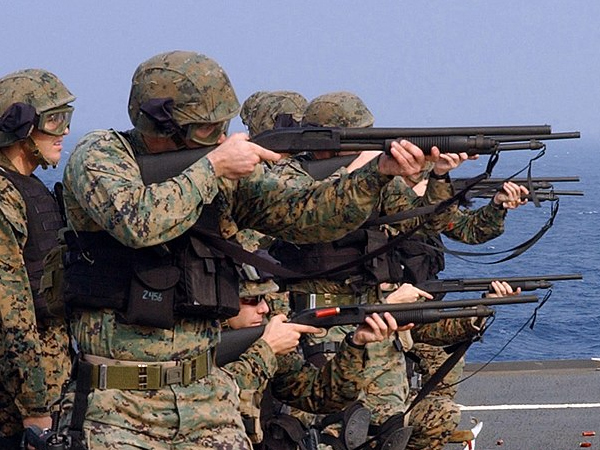
The United States Navy opts to replace the standard rifle qualification of most branches with a shotgun alternative.
Thus, the Navy “rifle” qualification actually consists of firing a Mossberg 500.
The Navy shotgun qualification is composed of a course with 4 separate firing stations:
- Station 1: Recruits fire shells standing behind a tall barricade 25 yards from a target.
- Station 2: Recruits kneel behind a low barricade and fire shots from 20 yards.
- Station 3: Recruits use the Mossberg 500 from 15 yards out with no barricade.
- Station 4: The final firing station exists 10 yards from the target with no barricade.
As you can see, the Navy rifle/shotgun qualification is distinguished by 4 individual firing stations each with their own firing position.
The first two stations require using the firearm behind a barrier either standing or kneeling (4 rounds).
Meanwhile, the final two stations do not include a barricade and test your accuracy from an upright position.
Additionally, it is important to remember to clear your weapon at the completion of the exercise to avoid getting deducted points because of safety concerns.
Navy Rifle / Shotgun Points System
The Navy determines if you pass the rifle/shotgun qualification based on accuracy with the targets.
Recruits must have at least 30 shotgun pellets hit each target on the course (4 total).
The max score possible on the Navy rifle assessment is 162 points whereas a minimum of 90 points is needed to pass the test.
It may sound sophisticated, but considering that each shell consists of 9 pellets (and you get to fire 3-4 rounds per target) – accuracy is achievable with a little practice and knowledge.
Thus, paying attention during Navy weapon qualification orientation and during the simulated exercises gives you an advantage over other new recruits.
Related Article – Navy SEAL Weapons and Gear
What is the Navy Pistol Qualification?
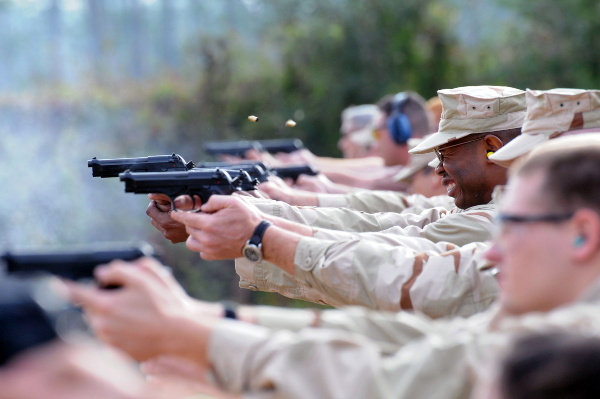
The U.S. Navy designates the M-9 pistol as its training weapon for the handgun portion of the qualification.
As a result, the standard Navy M-9 pistol qualification course presents 3 different phases.
All in all, the 3 phases of pistol training culminate in 48 live rounds.
Recruits spend time firing the M-9 pistol from various distances, like the shotgun qualification:
- 3-Yard Range: Recruits fire a total of 12 rounds from this distance.
- 7-Yard Range: Recruits unload a total of 12 rounds with both hands.
- 15-Yard Range: Recruits fire a total of 24 rounds, including shots fired from a kneeling position.
The Navy once again stipulates the number of rounds you can fire from a specific distance along with stances allowed at each station.
Recruits are allowed to fire 12 rounds each from the 3-yard and 7-yard markers.
However, there are different expectations at each station.
For example, the first station tests your accuracy firing the M-9 pistol with both your dominant hand and weak hand.
Like the 7-yard marker, the first station is timed so specialists learn how to reload and fire the weapon under pressure to determine if accuracy changes as a result.
Then, at the final station (15-yard line), recruits have double the ammunition (24 rounds) to complete the exercise.
The final station once again assesses your accuracy from a further distance while also having to holster and reload the weapon.
Additionally, recruits switch between a standing and kneeling position while firing rounds at the 15-yard line.
Navy Pistol Points System
Points are awarded depending on which area(s) of the human-shaped target you hit.
Consequently, some vital areas (head, chest, etc.) are worth more points compared to other parts of the body (hands, legs, etc.).
The purpose of the exercise is to achieve a minimum score of 180 points.
We could get into the specific requirements of each shooting station but you’ll learn all you need to know about the Navy rifle and pistol qualification during orientation.
Related Article – Army Ranger Weapons and Gear
Navy Marksmanship Awards
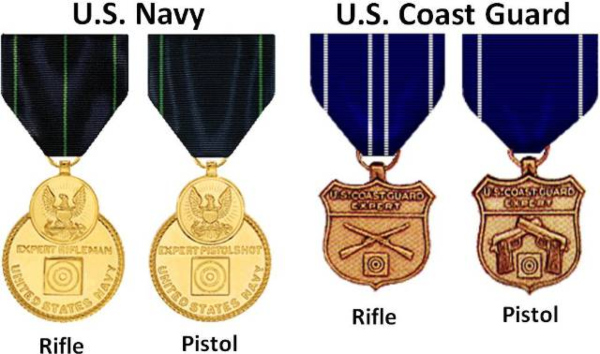
The Navy rifle and pistol qualification requires new recruits to master the M-9 pistol and Mossberg 500 shotgun during boot camp.
Recruits get the opportunity to learn about safely handling and loading weapons during orientation, which is unique to the military branch.
Then, new military personnel get the opportunity to qualify and compete throughout the marksmanship courses.
The Marksmanship Medal is the highest award that one can receive for weapons qualification in the U.S. Navy and Coast Guard.
Sailors may qualify for any marksmanship awards with the M-9 pistol during boot camp. They may also qualify at a later date for the Rifle component using an M-16 or M4 Carbine.
Keep in mind that you do not need to successfully complete the M-16 and M-4 training to graduate from basic training.
Nonetheless, proving your worth with either semi-automatic weapon can earn you a marksmanship medal.
Those that qualify for weapons distinction within the military branch are authorized to wear one of the two decorations (separate for pistol and rifle qualifications).
It is also possible to obtain a medal for each designation (Navy rifle and pistol qualification) for simultaneous wear.
Marksmanship Awards – Points Structure
In order to qualify for the Navy rifle or pistol Marksmanship Medal, you must achieve the following score on an approved weapons qualification course:
| Marksmanship Medal (Qualification) | M-9 Pistol (Target Score) |
|---|---|
| Marksman | 180-203 |
| Sharpshooter | 204-227 |
| Expert | 228-240 |
Meanwhile, sailors have the option of testing for the rifle qualification using either the M-16 rifle or M-4 carbine:
| Marksmanship Medal (Qualification) | M-16 Rifle (Target Score) |
|---|---|
| Marksman | 140-159 |
| Sharpshooter | 160-169 |
| Expert | 170-200 |
You’ll note that the U.S. Navy does not feature any marksmanship awards for the Mossberg 500.
Regardless, you must learn to master the weapon as meeting the basic requirement is mandatory along with the M-9 pistol qualification for boot camp.
The Navy Marksmanship Team holds noteworthy competitions that have existed in the branch since 1907.
How Should I Prepare For The Test?
The U.S. Navy does an outstanding job (perhaps better than any other branch outside the Marine Corps) in preparing sailors to handle weapons.
It actually has classroom studies dedicated to handling weapons along with simulated training before your first day on the range.
Regardless, preparation is crucial to succeeding in any field, including marksmanship.
Thus, if you have a goal to achieve the Sharpshooter or Expert Marksmanship Medals in the U.S. Navy, then you’ll have an opportunity to start training after boot camp.
Of course, your training opportunities may be limited due to the weapons that you are legally allowed to possess along with access to a safe and protected firing range.
There are many courses available that can gain you invaluable time and experience firing pistols, shotguns, or rifles prior to enlistment.
You should consult local gun ranges or safety classes for more information.
Related Article – Marine Corps Combat Marksmanship Coach (MOS 0933)
Conclusion
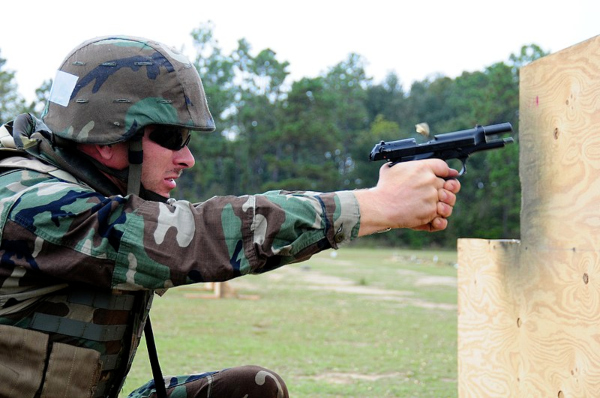
The Navy rifle and pistol qualifications exist to prepare every recruit for safe and accurate handling techniques.
The military branch brings along new recruits slowly as they engage in classroom studies and simulated activities before advancing to the gun range.
There is no requirement to qualify with a rifle during Navy boot camp, unlike other military branches. Only the Mossberg 500 shotgun and M9 pistol are taught during Navy basic training.
However, advanced shooters may want to consider competing for a Marksmanship Medal using a rifle after completing boot camp.
The Navy does require that every new recruit learn how to handle a shotgun (Mossberg 500) though no awards exist for shotgun qualification.
Advanced marksmen can obtain a ribbon or medal based on the test score for the Navy rifle and pistol qualifications.
See Also
Scholarships for Military Children, Spouses, and Veterans
- Replacing Dog Tags: 6 Things You Need to Know - June 28, 2024
- Navy OAR Test Study Guide - June 24, 2024
- 10 Best Sniper Movies of all Time - June 20, 2024

